Outdoor swimming can – and should – be a year-round pleasure. And now is the perfect time to make a start. January is a terrible month to try and muster willpower: too dark and cold. But start swimming now – when the sun has had a chance to warm our rivers and lakes – and the momentum can take you through to next summer.
Four years ago, I decided to swim right around the calendar. As the leaves fell and I stared suspiciously at the brown swimming pond in my local park, an older woman in rubber hat and neoprene gloves climbed casually down the ladder and into the water. Her strategy, she told me later, over a foot bowl of warm water, had been to simply keep swimming, at least once a week, for as long as she could bear it. Come rain, snow or wind, she walked down, stripped off, had a plunge and headed home again – just to see how long she would manage. Before she knew it, summer had arrived and she had done an entire year. As the Outdoor Swimming Society puts it, “It is easier to start your swimming career in spring or summer, at 16C and above, and then keep on swimming as the temperature drops.”
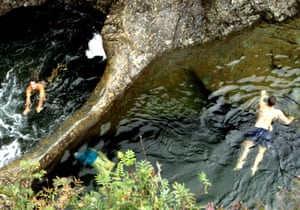
As long as you stay acclimatised, by swimming at least once a week all year round, your body will adapt to the drop in temperature. The stress reaction to cold water – the breathlessness, the shivering, the need to pee, the raised heart rate – all reduce in intensity the more often you swim outdoors. In March, the sea feels less cold to me than it would to someone who hadn’t been in since June.
Not many of us have the choice of river, lake, pond or sea in which to wild swim, but one of these, at least, is never far away. The sea will always be the warmest, while a high, fast-moving stream or deep dark lake, can be shockingly cold. I prefer rivers for the views. But once you’ve broken the taboo of wild swimming, you quickly find that you can get in anywhere. I have swum in the Thames by London’s Hammersmith Bridge, in the chip-scented sea off Barry Island in south Wales, in a river next to a light industrial unit on Wallasea Island, Essex, and in many city parks, watched by bemused tourists. The world’s your oyster, if you’re just prepared to get a bit wet.
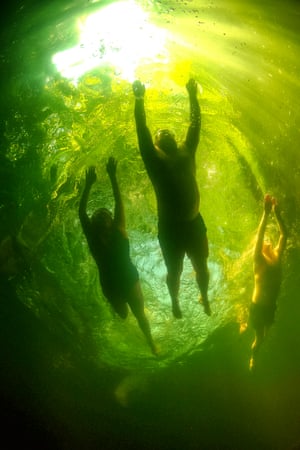
Five ways to keep the habit going
1. Get the right kit
The feel of freezing water washing across your skin can be agony, but it is easily avoided. Among my best investments are a pair of neoprene swimming socks and wetsuit gloves. Not only will you be able to swim for twice as long but once you get out, you won’t freeze. I have strolled across pebbles in Dorset and through thick Essex mud without a care.
2. Take someone with you
While it’s lovely to have someone there to pass you a towel and some socks, the priority is safety. Someone should be there checking that you haven’t got into trouble. Although we are free of sharks and crocodiles, there are still the dangers of strong currents, tides, temperature and visibility – so always swim in company. Get out the moment you feel sleepy or too cold, and know how to get out before you get in.
3. Appreciate the view
It’s easy to get distracted by the strong physical sensations of cold-water swimming, especially in the early days. But it’s worth trying to take in your surroundings from a whole different perspective. Look up at the sky, listen to the birds and enjoy the view. Those are the memories that will stay with you far longer than the shivers.
4. Layer up
Once you get out, make sure you warm up as quickly as possible. If possible, take a warm shower or stand in a tub of warm water – but don’t heat your body up too quickly. Always try to put on at least one more layer than you were wearing before you went into the water, pack an extra jumper, and don’t forget a hat to keep your head warm.
5. Don’t overdo it
There have been days in the last few years when all I could manage was to jump in, swim a couple of strokes, then get out and start eating flapjacks. This isn’t a competition. You don’t need to go any further or stay in any longer than you want to. A couple of seconds of liberated splashing is better than nothing at all.
For more tips on wild swimming safely, see outdoorswimmingsociety.com
Five wild swims, by Sophie Pierce
Best for waterfalls/natural Jacuzzis: Sharrah pool, river Dart, Devon
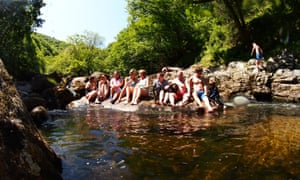
Trek upstream into ancient oak woodland following the course of the river Dart, plunging in a series of natural jacuzzis along the way. Pass Horseshoe Falls, Wellsfoot Island and Bell Pool to arrive at the legendary Sharrah pool. Do the “Sharrah Chute”, which involves climbing on to Elephant Rock,and then jumping out into the current and getting swept away in the churning rapids. Just down from the cascade, you zoom through a rectangular channel, with walls of granite, before the pool opens out into a vast oval.
Island swims: Loch an Eilein, Rothiemurchus, Scotland
Rising from the waters of Loch an Eilein is an island with a ruined, ivy-clad castle. It is incredibly picturesque, and the perfect swimming destination if you’re looking for splendid isolation and romantic settings – so long as you pack your wetsuit (it’s freezing). The 600-year-old castle fell into disuse several hundred years ago. Although the castle is only 100m from the shore, the backdrop of the Cairngorms rises thousands of metres high. Where the castle wall meets the water there is a small doorway, which you can go through. Inside, the old hall is complete with a tumbledown fireplace and trees growing through the roof.
Jumps and rope swings: Outney Common, River Waveney, Suffolk
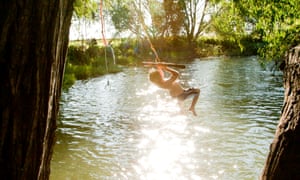
The river Waveney is the southernmost and most beautiful of the Norfolk Broads, and was the local river of the late Roger Deakin, father of wild swimming. Outney common is one of the best places to explore, with excellent access for more than a mile. You can also hire canoes.
Hidden rivers and skinny-dipping: Rhaeadr Ddu, Maentwrog, Gwynedd
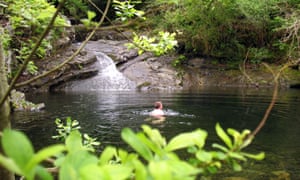
This dramatic gorge is surrounded by thick woodland and has a secret waterfall with large plunge pool, once admired by Victorian travellers but now well off the tourist track. The adventurous might like to find the ruined medieval bridge with more amazing pools upstream by 500m.
Swim safari: Yealm estuary, Noss Mayo, Devon
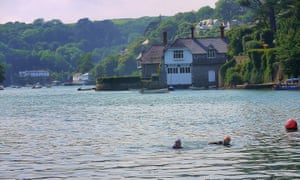
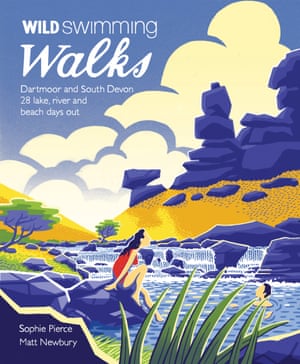
Swimming from Cellar beach up the Yealm estuary to the Ship Inn in Noss Mayo is enormous fun. It’s about 1½ miles, but an incoming tide helps swoosh you upstream. It’s a bit like flying as you whizz over the seabed below. You may see shoals of sand eel, as well as bass and mullet. Wear a bright swimming cap so you can be seen by the many boats in the estuary.
Wild Swimming Walks: Dartmoor and South Devon by Sophie Pierce and Matt Newbury is out next week, featuring rivers, lakes and coast (Wild Things Publishing, £14.99). wildthingspublishing.com /product/wild-swimming-walks-dartmoor-and-south-devon/
Source: Read Full Article
